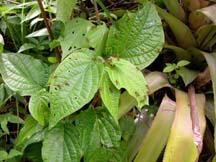
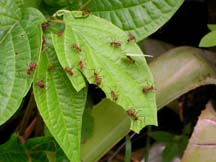
Workers of Atta colombica cutting leaves on Barro Colorado Island, Panama
| Genus List | Species List | Key to Species |
The tribe Attini is comprised of 12 genera and about 200 species, all of which are specialized cultivators of fungi. All harvest various substrates, concentrate the material inside nests, inoculate the substrate with specialized fungi, and use the resultant fungal garden as a food source. The genus Atta contains the largest and most conspicuous members of the Attini. They are the largest in terms of both worker and colony size. Colonies can be enormous, with millions of workers. The nests are in the soil and may be several meters across and several meters deep, with large piles of excavated soil on the surface. Workers cut leaf fragments from living vegetation for fungal substrate. Foraging columns form ribbons of green, snaking 100m or more through the forest, with thousands of workers returning with leaf fragments from trees that are being defoliated. Entire trees can be defoliated in a matter of hours. Atta are the primary agricultural pests in the Neotropics.
The main purpose of the "Atta of Costa Rica" web pages is to provide an identification guide to the Costa Rican species and to provide a few natural history notes on their distribution. The study of the Attini is a subdiscipline in itself, about which countless scientific articles, reviews, and books have been written. No attempt is made to summarize the biology here. Good introductions to attine biology are in Holldobler and Wilson's The Ants (1990) and Hanson's Hymenoptera of Costa Rica (1995). Also a large-scale collaborative effort to explore attine biology is being carried out by the combined labs of U. Mueller, C. Currie, and T. Schultz. The website of U. Mueller is a good portal to the work of this group.
Morphologically Atta's closest relatives are members of the genus Acromyrmex. Atta can be distinguished from Acromyrmex by the smooth gastral tergum. The gaster of Acromyrmex is coarsely tuberculate.
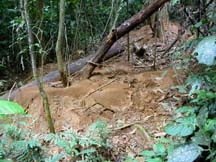


Workers of Atta colombica cutting leaves on Barro Colorado Island, Panama


Atta can make remarkable lines of shimmering color when cutting flowers
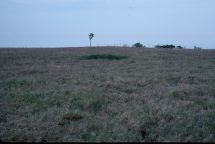

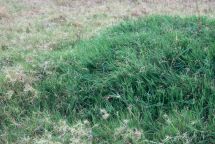
A green spot in a pasture reveals an abandoned Atta mound in Monteverde, showing effect on soil characteristics.
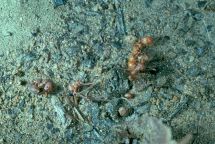
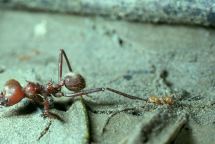
Colonies are territorial, and battles between colonies can last for weeks. Drift piles of dead ants may form at the contact zone.
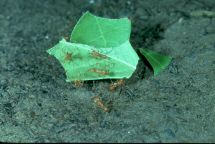
Small workers often "hitchhike" on cut leaves as they are carried back to the nest. They are thought to function in defense, protecting the leaf-carrying worker from attack by parasitic phorid flies.
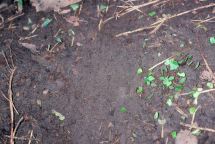
A swipe of the hand across a foraging trail removes trail pheromones, resulting in traffic jams on each side. Returning workers with leaves pile up on one side; outbound workers pile up on the other.

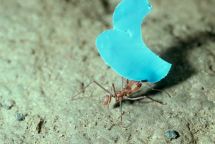
Workers do not always seem to make good choices. Here workers were cutting a blue plastic garbage bag at a field station. It was a comical site to see a blue line of little plastic bits trooping off into the forest.
Page author:
John T. Longino, The Evergreen State College, Olympia WA 98505 USA.longinoj@evergreen.edu